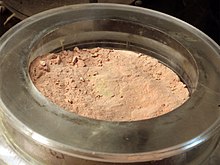Plutonium(IV) fluoride is a chemical compound with the formula (PuF4). This salt is generally a brown solid but can appear a variety of colors depending on the grain size, purity, moisture content, lighting, and presence of contaminants.[4][5] Its primary use in the United States has been as an intermediary product in the production of plutonium metal for nuclear weapons usage.[3]
 | |
 | |
| Names | |
|---|---|
| IUPAC name Plutonium(IV) fluoride | |
| Other names Plutonium tetrafluoride | |
| Identifiers | |
3D model (JSmol) | |
| ChemSpider | |
PubChem CID | |
CompTox Dashboard (EPA) | |
| |
| |
| Properties | |
| PuF4 | |
| Molar mass | 320 g/mol |
| Appearance | reddish-brown monoclinic crystals |
| Density | 7.1 g/cm3 |
| Melting point | 1,027 °C (1,881 °F; 1,300 K) |
| Structure | |
| Monoclinic, mS60 | |
| C12/c1, No. 15 | |
Except where otherwise noted, data are given for materials in their standard state (at 25 °C [77 °F], 100 kPa). | |
Formation
Plutonium(IV) fluoride is produced in the reaction between plutonium dioxide (PuO2) or plutonium(III) fluoride (PuF3) with hydrofluoric acid (HF) in a stream of oxygen (O2) at 450 to 600 °C. The main purpose of the oxygen stream is to avoid reduction of the product by hydrogen gas, small amounts of which are often found in HF.[6]
- PuO2 + O2 + 4 HF → PuF4 + O2 + 2 H2O
- 4 PuF3 + O2 + 4 HF → 4 PuF4 + 2 H2O
Laser irradiation of plutonium hexafluoride (PuF6) at wavelengths under 520 nm causes it to decompose into plutonium pentafluoride (PuF5) and fluorine; if this is continued, plutonium(IV) fluoride is obtained.[7]
Properties
In terms of its structure, solid plutonium(IV) fluoride features 8-coordinate Pu centers interconnected by doubly bridging fluoride ligands.[8]
Reaction of plutonium tetrafluoride with barium, calcium, or lithium at 1200 °C give Pu metal:[4][5][3]
- PuF4 + 2 Ba → 2 BaF2 + Pu
- PuF4 + 2 Ca → 2 CaF2 + Pu
- PuF4 + 4 Li → 4 LiF + Pu
